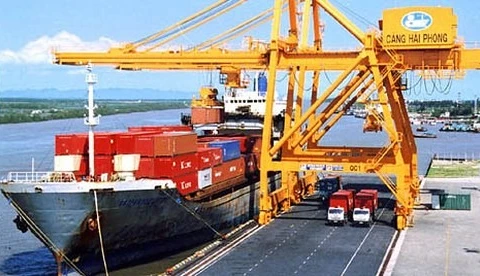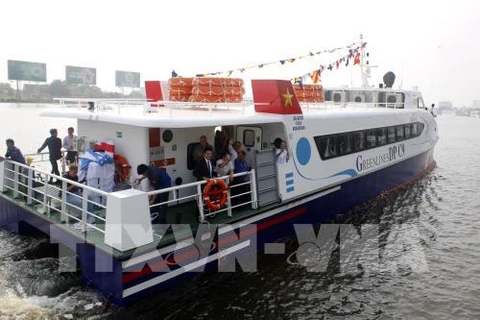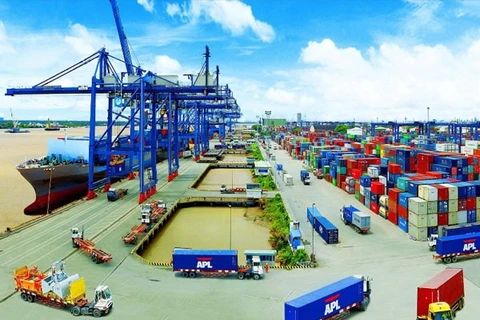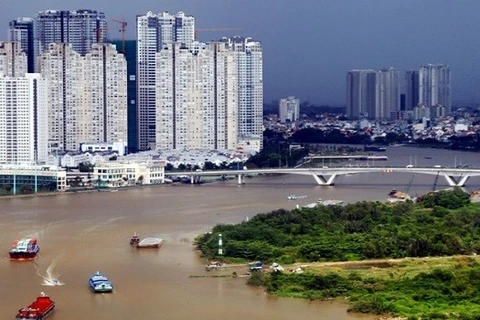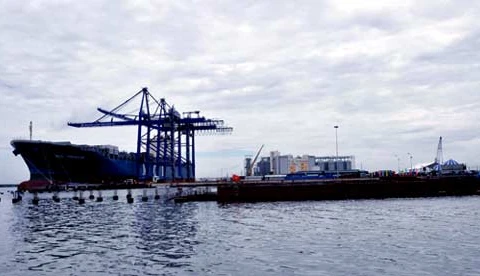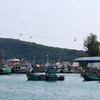 Deputy PM Trinh Dinh Dung (third from right) urged the Transport Ministry to further study improved waterway connectivity in the Mekong Delta Region. (Photo: chinhphu.vn)
Deputy PM Trinh Dinh Dung (third from right) urged the Transport Ministry to further study improved waterway connectivity in the Mekong Delta Region. (Photo: chinhphu.vn) Tra Vinh (VNA) - Deputy Prime Minister Trinh Dinh Dung has asked the Ministry of Transport to review transport planning in the Mekong Delta and seek better links among modes of transport in the region.
Deputy PM Dung called for further connectivity among inland waterways, marine routes and inland ports when he visited Quan Chanh Bo canal and Tat canal on Hau river in Tra Vinh province.
He asked the Ministry of Transport to study and develop transport options on connecting Tien river and Hau river.
The 250-kilometre-long Tien and 200-km-long Hau, tributaries of Mekong river, are two major rivers in the delta, which is the country’s largest rice, fruit and seafood producer.
According to experts, a coastline that is more than 700km long as well as numerous canals and rivers that crisscross each other make the Mekong Delta an ideal location to develop an efficient waterway transport system that will boost commerce and ease road traffic congestion.
Under a national plan on sea port system development, Hau river is among key projects that will receive priority investment to be completed by 2020.
In 2007, the Transport Ministry approved a project on dredging and deepening Hau river to make it navigable for vessels of up to 10,000 tonnes. Work began in 2009 in Duyen Hai district, Tra Vinh province.
The 46.5 km of deepened river consist of four parts – 12.1 km on Hau River, 19.2 km on the Quan Chanh Bo canal, 8.2 km on the newly dredged Tat canal and 7 km of marine route. Other work includes dykes, signal systems, sheltering areas and three ferry stations.
By the end of 2011, around 1 trillion VND (50 million USD) had been spent on the work when it came to a halt and could not be completed in 2013 as planned due to financial difficulties.
Following a two-year delay, work to dredge and deepen Hau river restarted after the National Assembly approved a 6 trillion VND (300 million USD) Government bond issue to fund it.
By April 2017, almost all of the work had been completed and operations begun. The Transport Ministry reported that of some items had not been completed due to landslides along Quan Chanh Bo canal and local residents refusing to move from the project’s area because of disagreements over compensation.
Previously, since only vessels of between 4,000-5,000 tonnes can navigate Hau river, 80 percent of cargo transported by sea to the Mekong Delta transits through ports in places like HCM City, Dong Nai, and Ba Ria-Vung Tau.
Deputy PM Dung said that the project on dredging and deepening Hau river passage was among efforts to help large vessels access inland ports, thus reducing transport costs.
It is expected that when Hau river becomes navigable for large vessels, 50 percent of cargo headed for the delta will come through it, reducing import costs and also boosting the competitiveness of the region’s exports.
Dung emphasized the need for continued efforts in further connecting waterways in Tra Vinh province and other Mekong Delta provinces as well.
Problems such as funding shortages, land clearance, compensation should be reviewed and tackled to ensure benefits of State, investors and local residents, he said.-VNA
VNA
